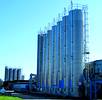
A plastics manufacturer in Hereford, UK, has recently solved its level measurement problems in 18 on-site silos with an integrated approach using guided microwave sensors linked to the PC network.
RPC Containers manufacture a range of food containers for leading food producers and retailers in the UK, making around 4 million items per week. The polymer used to supply the production lines fall into approximately six different types of polyethylene, which are stored in various quantities inside 18 silos in two blocks on the site.

Because of the high throughput, the silo inventory needs to be carefully controlled. Product levels were originally monitored using electro-mechanical 'plumb bob' devices. However, the devices were unreliable, unable to measure during filling, inaccurate and high in maintenance. The on-site engineers experienced regular cable breakages, weights being buried in the product and failure of motors and mechanical components, resulting in all too regular climbs to the top of the silos in all weathers to manually dip or carry out repair work at great heights.
The inaccurate readings from these 'plumb bob' devices often caused overfills on the silos. This would result in charges being levied for returned product due to aborted deliveries, and on the opposite side of the scale production sometimes running out of material. These inefficiencies, resulting in high maintenance and operational costs, drove RPC to look for a reliable solution.
Various options were looked at but in the end guided microwave (or TDR) level sensors were chosen because although in contact with the product, they are easy to fit, unaffected by filling or surface angles and the plastic granules would not cause any wear on the sensor cable.
The integration and distribution of the level information was also considered. The ability for the silo levels to be shared with the various departments such as production, purchasing, accounts and sales via the PC network was seen as an essential part of this upgrade.
Networked sensors
The networking idea was also extended to the sensors themselves, with multidropped devices all sharing a single two-core cable connecting via a simple 'T' connector. It uses the industry standard Profibus protocol and connects to a central signal processor fitted with a PC network card. This digital solution saves on cabling and installation costs and allows remote communications to each device for setting up, operation and maintenance from the PC network. There is also scope for expansion should any additional silos or other Profibus sensors be installed in the future.
The entire installation took place over a one-month period, including installing the signal cabling and special 'T' junction boxes. The guided microwave units were mounted in the same nozzle that the old level systems had been fitted to. Being able to fit a single cable, which supplies power to and data from each set of transmitters at the two silo blocks, was especially useful because the silos were in two different places a few hundred metres apart. The cable, when used in this format, can run in excess of a kilometre.

The Vega central signal processor unit was installed in the production office. Final commissioning of all 18 measurement sites took two days including setting up the local area network (LAN) connection to provide data for a networked spreadsheet for accurate, on-line inventory data. The equipment also has Internet Web-browser publishing capabilities, graphics and trend displays.
The increased reliability and accuracy of the measurement at RPC Containers has meant the system is now an integral part of material control for this site. Since the installation there have been no more overfills and no need for personnel to climb to the top of the silo to make repairs or manually dip the silos. The Vega level measurement solution has saved this manufacturer time, money and importantly, increased safety.
For more information contact Alan Wynn, Vega Instruments, 011 958 1901, [email protected], www.vega.com
| Tel: | +27 11 795 3249 |
| Email: | [email protected] |
| www: | www.vega.com/en/home_za |
| Articles: | More information and articles about VEGA Controls SA |

© Technews Publishing (Pty) Ltd | All Rights Reserved